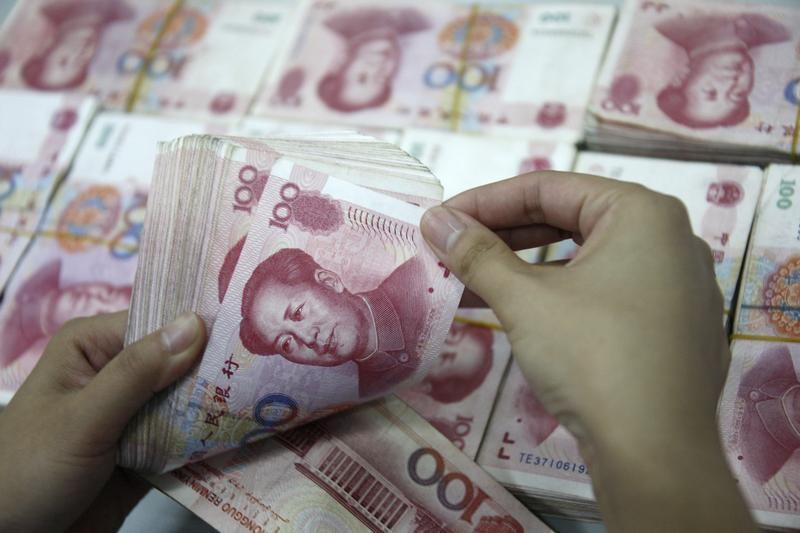By Jamie McGeever
LONDON, Oct 26 (Reuters) - Including the Chinese yuan in the
International Monetary Fund's benchmark currency basket would
give it an official seal of approval, eventually leading to
global demand worth more than $500 billion in coming years,
currency analysts say.
Inclusion of the yuan in the holdings of foreign exchange
reserve managers would be a gradual process, subject to external
factors with high degrees of uncertainty. But the yuan
eventually might comprise nearly 5 percent of global reserves.
The IMF's executive board is scheduled to decide in November
on the yuan's inclusion and is expected to give the green light,
although approval could be early next year, sources familiar
with the discussions told Reuters. urn:newsml:reuters.com:*:nL1N12Q021
Being able to buy and sell the yuan will require further
liberalisation of China's exchange-rate controls, a process that
has been years in the making and may take many more.
Still, demand for yuan from reserve managers could counter
the capital outflows from China. Those outflows have accelerated
recently to record levels as the economy has slowed and markets
have fallen.
Based on its inclusion in the IMF's Special Drawing Rights
(SDR) basket, a virtual currency that values IMF reserves and
emergency payouts to members, the yuan's share of the world's FX
reserves could eventually reach around 5 percent, analysts
estimate.
That would place the yuan, or renminbi, ahead of the
Canadian and Australian dollars (each almost 2 percent of
reserves, according to the latest IMF data) and near sterling
(4.7 percent), but still well behind the euro (20.5 percent).
The U.S. dollar remains the world's pre-eminent reserve
currency, accounting for nearly two-thirds of all holdings.
In the SDR itself, there are only four currencies - the
dollar, euro, sterling and Japanese yen. The Canadian and
Australian dollars are not part of it. The yuan would be the
fifth.
"You don't have to be in the SDR to be a reserve currency.
It helps, but it doesn't particularly matter," said Simon
Derrick, global head of currency strategy at Bank of New York
Mellon in London.
"It's a guessing game, but within a few years the yuan would
probably be of similar size to the Canadian dollar, and well
within the next decade not hugely dissimilar to sterling," he
said.
World FX reserves stand at around $11.46 trillion, of which
the composition of $6.666 trillion is known. It is assumed the
remainder is along similar lines.
The total value of SDRs is only around $280 billion. Its
composition, which factors in currency use in international
trade flows, is rather different. Last set in 2010, it is 41.9
percent dollar, 37.4 percent euro, 11.3 percent sterling and 9.4
percent yen.
SWIFT ENTRANCE
Earlier this year, analysts at Citi conducted a "very
informal" survey of 12 reserves managers with more than $2
trillion of FX reserves under management, asking whether the
yuan's SDR inclusion would make them more inclined to add it to
their FX reserves. The response was that it would.
"SDR inclusion makes the RMB, by definition, a 'reserve
asset', and this should catalyse capital inflows to China, but
by how much, it's hard to say," said David Lubin, head of
emerging market economics at Citi in London.
"And since China should expect to see gross capital outflows
for the foreseeable future, it's not even clear that SDR
inclusion will lead to a net capital inflow to China," he said.
Li-Gang Liu of Washington-based Peterson Institute for
International Economics argued in an opinion piece earlier this
year that SDR inclusion would not automatically grant it reserve
currency status.
That will be determined by financial markets, based on
"risk, return, liquidity, ease of hedging, and other market
efficiency criteria," he said.
Based on current methodology, the yuan's SDR composition
could be around 14 percent, according to HSBC. But it will be
lower if the IMF factors in its use in financial transactions,
"the RMB's weak point," the bank said in a recent note.
They argue that market-friendly FX and other reforms being
undertaken by Beijing in the face of serious economic challenges
override the "symbolic" benefits offered by SDR status.
Against a backdrop of easing monetary policy and narrowing
growth differentials with the rest of the world, continued
capital outflows should weaken the yuan over the next year to
6.60 per dollar CNY= from 6.35 currently, they said.
Barclays (L:BARC) are even more bearish, calling for the dollar to
hit 6.90 by the middle of next year, and possibly higher.
Still, the yuan is now the fourth most-used world payment
currency, accounting for a record high market share of 2.79
percent in global payments, according to global transaction
services organization SWIFT.
Reserve managers looking to build up their renminbi holdings
will want to do so gradually and in a manner that increases
their portfolio diversification. That would likely see them trim
their dollar and euro holdings, BONY Mellon's Derrick said.
